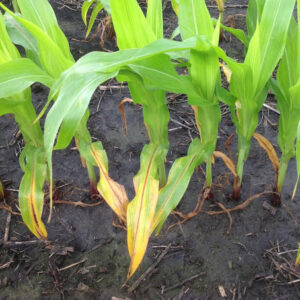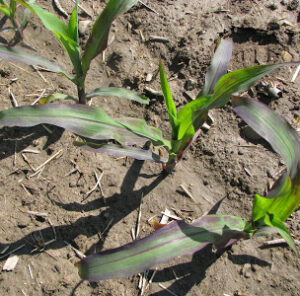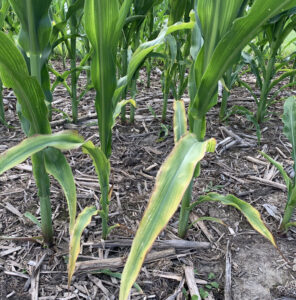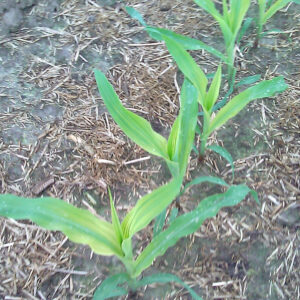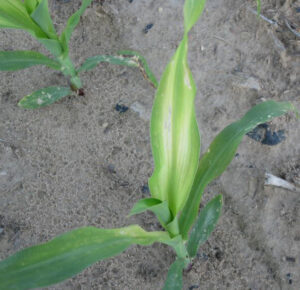Nutrient Deficiency
- Visual Symptoms: A Handy Tool in Identifying Nutrient Deficiency in Corn, Cotton and Soybean. 2021. Adotey N., A.M. McClure, T.B. Raper, and R. Florence. Extension Publication, W976.
- Reference Sufficiency Ranges for Plant Analysis in Southern Region of the United States. 2013. Campbell, R.A. Southern Cooperative Series Bulletin #394. NC Dept. of Agriculture and Consumer, Raleigh, NC.
- Visual Symptoms: A Handy Tool in Identifying Nutrient Deficiency in Row Crops. 2020. Adotey, N. A.M. McClure, and T.B. Raper. UTCrops News Blog.
Plants require balanced nutrition for optimal plat growth and development. Plants respond to malnutrition by showing visual symptoms. Generally, a nutrient deficiency occurs as a result of low soil nutrient levels. However, prevailing environmental conditions, soil properties, growth conditions and root diseases may restrict nutrient uptake and induce deficiencies in crops even if soil nutrient levels are estimated sufficient for optimum yield. For example, low or high soil pH, soil compaction and excessively wet or dry soil may prevent nutrient uptake. A handy diagnostic tool to identify nutrient deficiency in crops is via visual observation of symptoms. However, this tool may not always provide a definite diagnosis of the nutrient status of the plant. To address this, visual symptoms should be corroborated with plant tissue and soil testing, and examination of the history of nutrient applications to the field. Adequate knowledge of visual symptoms and tissue testing may help guide
corrective actions in-season or preventive action in the following season to avoid yield loss.
Knowledge of the nutrient deficiency symptoms and underlying causes can play important roles in diagnosing problems in the field. In diagnosing a nutrient deficiency symptoms, the following important questions should be addressed; (1) Is this a nutrient deficiency problem? (2) Where does the symptoms appear first? and (3) What is the form of the symptoms?
Is this a nutrient deficiency problem? Pattern or lack of pattern on the crop or within the field provides an indication if the symptom is a nutritional deficiency or other factors. If there is lack of pattern on the leaves or the crop or within the field, the symptom is usually due to an insect or disease. The symptoms may have a path but not a pattern. Nutrient deficiency symptoms have a pattern on the leaves, or the plant or within the field. In the field, these symptoms may occur in irregular (often related to soil conditions) or regular patterns ( often related to cultural practices). When the leaves of affected plants are folded down the middle like a book, the pattern of symptoms should match up as shown below (Yes).
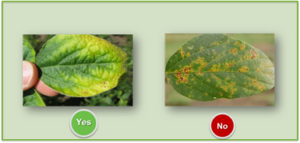
Where does the symptoms appear first? Where the symptomology occurs on the plant depends on the mobility of the nutrient within the plant (Figure 1). Plant nutrients can be classified as mobile or immobile within the plant. Mobile nutrients such as N, P, K and Mg can be translocated from the older leaves to the developing plant parts. Hence, deficiency symptoms tend to show on older, lower leaves. On the other hand, immobile nutrients like Calcium (Ca), Sulfur (S), and most micronutrients have limited mobility within plants and deficiency symptoms occur in younger, upper leaves.
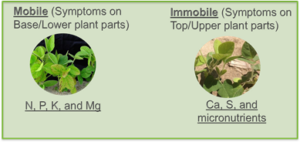
What is the form of the symptoms? Symptoms associated with deficiency may take several forms including chlorosis, necrosis, and abnormal growth. Chlorosis occurs when the production of chlorophyll is reduced which results in a yellow to pale green leaf color. Nitrogen (N), magnesium (Mg), sulfur (S), and iron (Fe) are nutrients that play important roles in chlorophyll production and function; hence, their deficiencies tend to cause chlorosis. Necrosis is when the plant tissue dies. Necrosis is commonly associated with N, phosphorus (P), and potassium (K) deficiencies. Abnormal growth occurs when inadequate amounts of a nutrient in the plant restrict cell elongation and replication resulting in stunted growth, deformation or crinkled leaves.
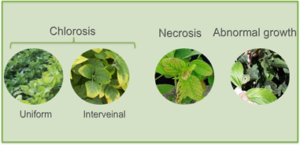
An easy way to identify nutrient deficiency is to employ a similar approach as the dichotomous key approach. The dichotomous key consist of two contrasting question which will provide a stepwise guide towards identifying each entity. Below is a figure using dichotomous key to identify symptoms on the bottom of the plant as well as the top of a soybean plant.
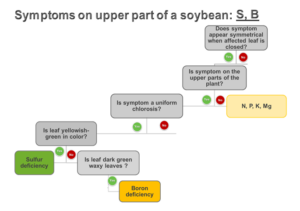
Tissue testing is a management tool to diagnose nutrient deficiency and monitor the nutritional status of crops. Based on this testing, timely corrective in-season or preventive action in subsequent season can be taken to improve the crop’s nutrient status and productivity. The most commonly used method for interpreting tissue testing in soybeans is the sufficiency ranges. UT’s tissue analysis recommendations are based on SERA-IEG-6 publication titled “Reference sufficiency ranges for plant analysis in the Southern Region of the United States”.
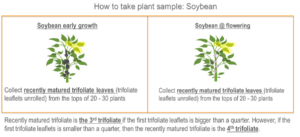
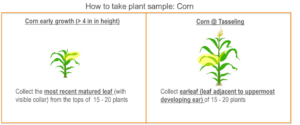
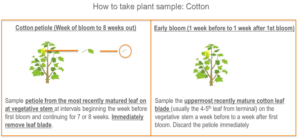
Nutrient Deficiency Symptoms for Corn, Cotton and Soybean Nitrogen
Corn
Corn plants with N deficient leaves. Nitrogen deficient leaves showing a V-shaped yellowing starting from the tip and progressing down the midrib towards the base of the leaf. Appear first on older (lower) leaves. Photo from UM Extension
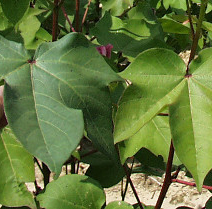
Cotton
Healthy leaf (left) and an N deficient leaf (right). Nitrogen deficient leaves are pale or yellowish-green in color with reduced leaf size. Symptoms appear first on older (lower) leaves. Photo from CDFA.
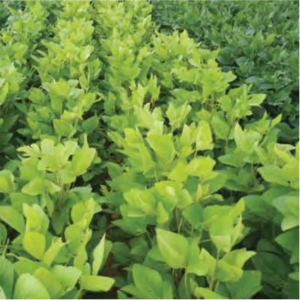
Soybean
Healthy soybean plants (Dark green plant on the right corner) and N deficient plant (middle). The leaves of N deficient plants are yellowish-green in color. Symptoms appears first on older (lower) leaves. Photo courtesy of Arkansas S P H
Phosphorus
Corn
Corn plants with P deficient leaves. Phosphorus deficient leaves with a reddish-purplish leaf tips with margins. Visual deficiency symptoms appear first on older (lower) leaves. Photo from Moe’s Diagnostic Centre.
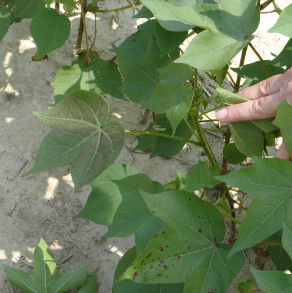
Cotton
Cotton plant with a P deficient leaf. Phosphorus deficient leaves are dark green in color and may turn reddish-purple. Symptoms appear first on older (lower) leaves. Photo from CDFA.
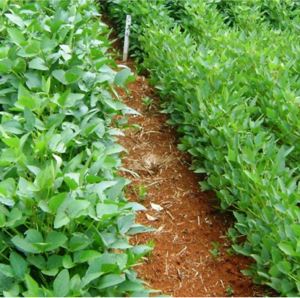
Soybean
Healthy soybean plants (left) and P deficient plant (right). Phosphorus deficient plant with stunted growth and lack of canopy. Affected leaves may be dark green to bluish leaves . Symptoms appear first on older (lower) leaves. Photo from Nebraska Inst. of Agric. & Nat. Res.
Potassium
Corn
Corn plants with K deficient leaves. Potassium deficient leaves are yellowish green in color. Yellowing starts from the tip of the leaves and progresses along the edges towards the base of the older (lower) leaves. Margins of leaf turn brown, as tissue dies. Photo courtesy University of Purdue.
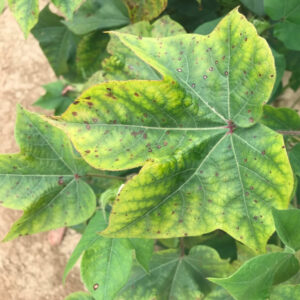
Cotton
Cotton plant with a K deficient leaf. Potassium deficient leaves show interveinal chlorosis, beginning from the leaf tip and margins. Early season (early bloom) deficiency symptoms appear first on older (lower) leaves while late season (late bloom) deficiency appears on younger (upper) leaves. Photo courtesy of Tyson Raper.
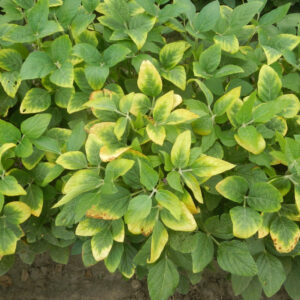
Soybean
Soybean plant with K deficient leaves. Potassium deficiency is associated with interveinal chlorosis that begins from the leaf tip and margins. Chlorosis then progresses to necrosis. Symptoms appear first on older (lower) leaves. Photo from MSU Extension.
Sulfur
Corn
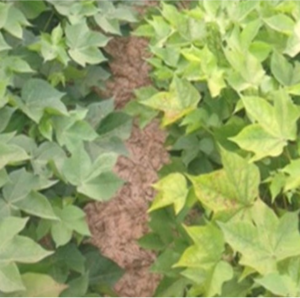
Cotton
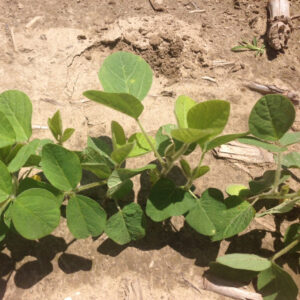
Soybean
Magnesium
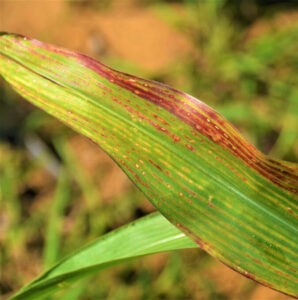
Corn
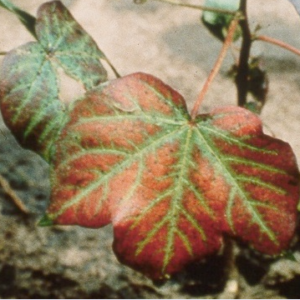
Cotton
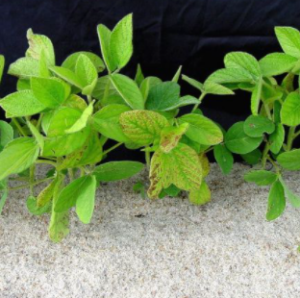
Soybean
Soybean plants with Mg deficient leaves. Magnesium deficient plant with interveinal mottling of leaves and interveinal necrosis. Symptoms appears first on older (lower) leaves. Photo courtesy of the Nebraska Institute of Agric. & Natural Resources.
Boron
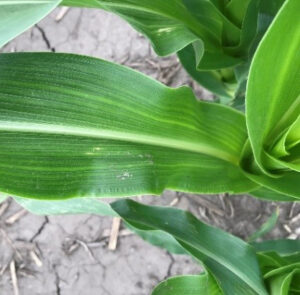
Corn
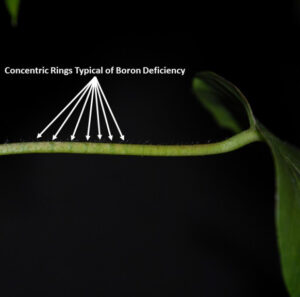
Cotton
Boron deficient cotton leaf. Boron deficient leaves show appearance of dark bands on the petioles. Symptoms appears first on younger (upper) leaves. Photo courtesy of Mississippi State University Extension.
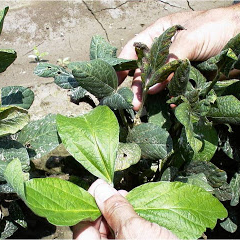
Soybean
Soybean plants with B deficient leaves. The leaves of S deficient plant are darker green in color and distorted/deformed. Plants may show waxy leaf surface. Symptoms appears first on younger (upper) leaves. Photo courtesy of the University of Arkansas Soil Fertility Program.
Zinc
Corn
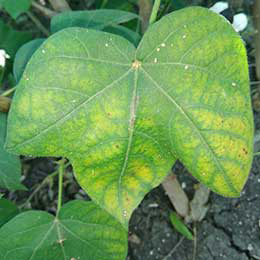
Cotton
Zinc deficient leaf showing pale yellow color but the veins remain green. Appear first on younger (upper) leaves. Photo courtesy of Aries Agro Limited.

Soybean
Soybean plant with zinc deficient leaves. Zinc deficient leaves show interveinal chlorosis and leathery upturned leaves. Appear first on younger (upper) leaves. Photo courtesy of University of Minnesota.


